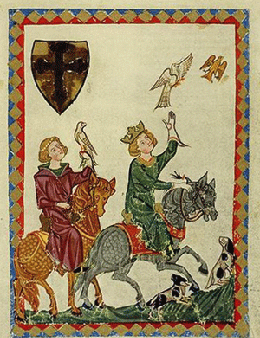The Fortress in the Forest
When the first Kerrs settled in the valley of the Jed Water in the late 13th century, the land surrounding Jedburgh was thickly wooded with great oak trees; the haunt of stag, of wild boar and wolf. Known as Jedwood it was a royal forest, managed to provide a playground for kings and princes to enjoy the thrill of the chase. At the close of the century the political manoeuvrings and subsequent campaigns of Edward I had taken their toll on a relatively peaceable kingdom centred on the great abbey communities founded by David I in the 12th century. The port at Berwick upon Tweed was inaccessible, the wool trade died, and the land became a settling ground for the disputes between the English king and the Scots. A patriarchal society rapidly developed. The era of the Border Reiver had begun, where only the strong would survive and those without lands or title would offer their allegiance to a clan chief with influence, power and cunning.
The next three centuries saw the border turmoil rise to a peak of lawlessness that would leave its stain on the history of Northern Britain. The Kerrs played a strategic game on this chequered board of kings and queens, bishop, knights, castles and pawns, and from the 14th century to the present day Ferniehirst Castle has remained in the possession of the Kerr family.
Fortified dwellings were constructed. From Hermitage Castle on the western Marches to Etal in the east. Pele towers and castles were built by the 'Names' granted possessions throughout the borderland. The Kerrs, having established themselves as landholders at a place they named Kersheugh, built their stone tower at Ferniehirst. Strategically situated with an eye on the old Roman road known as Dere street and within a short distance of the border with England. Possibly a timber construction came first and in 1470 Sir Thomas Kerr constructed a stone pele surrounded with a barmkin wall to hold livestock. With the growing power of the Kerrs during the late 15th century the building developed to become a fortress with the strength and position to maximise the defence of its walls.. The castle sited on an escarpment, known as a hirst was concealed in an area of dense oakwood and offered a strategic advantage resulting in the attacker experiencing problems using ordnance, the deployment of large groups of fighters in an advance and making the employment of a longbow or siege engine impractical. In 1523 English troops encountered these problems before gaining ground and taking the castle.
Jedwood, where the Kerrs first settled at Kersheugh, was a favourite hunting forest for both English and Scottish royalty. Ownership changed hands on several occasions.
A description of the struggle is contained in Lord Surrey’s account sent to Henry VIII in September of that year. “Ferniehirst” ……..Which “ stode mervelous strongly, within a great woode, and whose lord was his mortal enemy “.......... “with him went two knights, 800 men, and dyvers other good peces for the feld.” Entering the wood on foot, in two detachments, the Englishmen met with a spirited resistance from “ hardy men”,so that they were obliged to call for reinforcements. Still they failed to bring the ordnance to bear on the castle, “after much labour and long skirmishing, they gat forthe th’ ordynance within the howse and threwe downe the same.”
clankerr.co.uk© 2011 • Privacy Policy • Terms of Use

